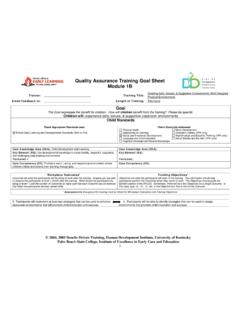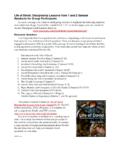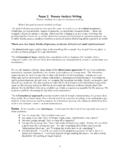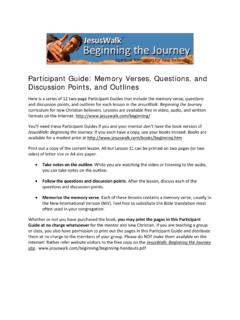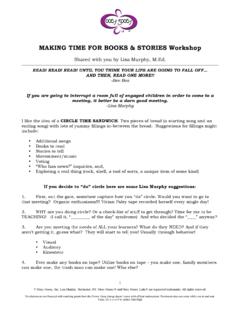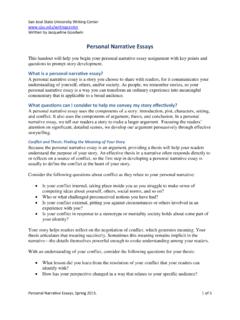Transcription of Tim’s Behavior Support Plan - University of South …
1 Handout :Individualized Intensive InterventionsModule 3b The Center on the Social and Emotional Foundations for Early Learning University of Illinois at Urbana-Champaign (p. 1/3)THE PROBLEMThe purpose of the Behavior :In group play situations (outside play/centers), Tim uses verbal aggression (threats), physical aggression(hit, push, kick, punch), and property destruction (throwing or banging toys) to obtain toys and/or joinplay. When this occurs, the peer relinquishes the desired toy and leaves the play area and/or an adultintervenes and provides Tim with excessive negative will grab toys, scream, and use physical aggression to obtain toys when peers suggest that theyplay with toys in a new way, propose a different play theme, or join in his play.
2 When this occurs, thepeer gives in to Tim s ideas, relinquishes the toy, or asks a teacher to TO DO ALL OF THE TIMET hese strategies will assist Tim in meeting the demands of difficult activities and social Play Skills Support providers should enter into play activities and teach Tim new play can provide Support by scaffolding Tim s interactions in play routines outside and during example, an adult could invite Tim into a center and then model or direct his play with Social Interaction Skills Adults should assist Tim with turn taking interactions by moving intoplay activities and mediating his social exchanges.
3 For example, sit with Tim and a peer. Tell the peeryou want him to help Tim to play with _____. Give the toy to the peer. Cue Tim to attend. Look is pushing the caboose around the track. Then cue Tim to take a turn. Tim, say Can Iplease have a turn? . Then scaffold the interaction to insure that Tim gets a turn with the Communication Repair Strategies Adults should facilitate the use of communication repairstrategies by Tim. Tim may use unintelligible mumbling or aggression if adults fail to quickly interpret hismessage. Strategies that may be used should include:Interpret Tim s actions as if they are communicative ( , Tim, you seem mad that Lenka took yourfavorite magnet person.)
4 Ask her for a turn. Say, Can I play with the person? )SHORT TERM PREVENTION STRATEGIEST hese strategies are used prior to situations that usually evoke challenging Behavior from Story Pre-teach Tim, through the use of a scripted story, the following skills: asking to play,everyone can play (turn-taking), being flexible and accepting other s ideas and space, and asking theteacher for help. Each skill will be taught one at a time to insure understanding of the skill use andsuccess in building upon each skill. Note: the scripted story will include clear expectations for Tim sbehavior, the perspectives of peers, the perspectives of Tim, and the communicative message of Tim sactions.
5 Tim s Behavior Support PlanRev. 1/06 Personal Cueing Tim will be cued with visual cue cards. The cue card is presented to Tim aftergaining his attention ( , directly given to him by showing him the picture cue along with simpleverbal cue). Cues will include directing Tim to stop and: 1. ask to play and join appropriately2. take turns3. go with the flow4. stop, think, and doSelf Management Tim will use a self-monitoring form to indicate if he accomplished his social skillsgoals. One goal will be introduced at a time. At the end of centers, a teacher will help Tim use theform to record if he was successful in meeting his goal(s) and then provide a certificate for Tim to takehome to celebrate the use of the new skill.
6 If certificate does not go home, no comment will be will be faded over Encouragement and Feedback Tim should receive statements about his use ofappropriate peer play Behavior frequently throughout the day in a natural fashion. ( , Look at youplaying with your friends. Everyone is getting a turn. )REPLACEMENT SKILLST hese are the new skills that will replace the use of the challenging to negotiate difficult social situations A scripted story will be developed and used to help Timidentify social cues, to introduce new routines and rules, and to teach him the social skills necessaryfor social play.
7 The following new skills will be included in the story: asking to play, everyone can play(turn-taking), being flexible and accepting other s ideas and space, and asking the teacher for skill will be taught one at a time to insure understanding of the skill use and success in buildingupon each to cope with negative emotions Tim will be assisted to identify the emotions that he is may use the Turtle Technique to calm down and think of a solution. Steps will include:1. Identifying feeling of (frustration, confusion, anger) and stopping2. Tucking into his turtle shell 3.
8 Taking 3 deep breaths (to calm down)4. Coming out of his shell to think of a solution (with adult s assistance)RESPONSES TO WHEN THE PROBLEM Behavior OCCURST hese responses will not reinforce the challenging Tim has difficulty with initiating interaction with his peers during play, anticipate the difficulty, and cuehim to ask to Tim has difficulty interacting with peers during play, anticipate the difficulty, and cue him to ask for Tim has difficulty with children playing with toys in a way that differs from the way he thinks the toyshould be played with, anticipate the difficulty, and cue him to go with the flow.
9 Handout :Individualized Intensive InterventionsModule 3b The Center on the Social and Emotional Foundations for Early Learning University of Illinois at (P. 2/3)Rev. 1/06If Tim has difficulty with interacting with peers during play and he needs help, cue him to stop, think,and do . Help him with what thinking of what to Tim becomes angry, confused, and/or frustrated and looks as if he is about to use aggression, cuehim to use the Turtle Technique, and help him through the Tim using aggression, intervene to prevent harm by providing attention/ Support to the child who ishurt and/or TO WHEN THE REPLACEMENT SKILLS ARE USEDT hese responses will reinforce the use of the new skills used to replace challenging Tim asks to play, scaffold play with Tim asks for a turn, scaffold turn-taking with Tim asks for help, quickly respond.
10 And help Tim uses any of the above skills, he should receive positive and reinforcing statements aboutappropriate Behavior in a natural fashion. ( , Look at you playing with your friends. Everyone isgetting a turn. )Handout : Meaning of Challenging BehaviorModule 3A The Center on the Social and Emotional Foundations for Early Learning University of Illinois at (P. 3/3)Rev. 1/06
